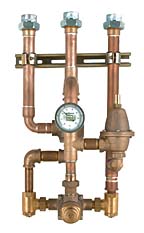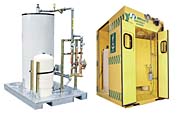Issue: 3/05
At the dawn of the 20th century, there were no emergency drench showers and eyewashes. Workers were generally considered lucky if there was a first-aid kit around! Industrial accidents-and even fatalities-were commonplace and accepted as an unfortunate, but necessary cost of progress. Concern for worker safety and governmental pressure led to the invention of rapid response equipment, including drench showers and eyewashes. Although equipment advances through the earlier years made the available products more effective, there was little regard for the effects of using ambient temperature water and overall victim comfort. More recently, ANSI and others began to focus on the effects of ambient temperature water on the comfort and well-being of the victim, as well as its impact on the required drench or irrigation cycle times.
For exposures to chemicals including corrosives (acids and bases), oxidizers, and solvents, as well as a host of other hazardous materials, ANSI Z358.1 requires a 15-minute drench or irrigation cycle using a shower or eyewash. A number of years ago, the standard was updated to include a provision that "tepid"

Warming Technologies
Generally speaking, tempered water blending systems consist of three major components: a hot water storage tank, a heater and a blending valve. A fourth component, a booster pump, is often specified where water pressure might be too low to run multiple pieces of emergency equipment at peak demand. Obviously, the specific requirements that the showers or eyewashes impose on the system need to be taken into account when sizing the componentry for the tempered water system. By considering the warming technologies and the showers and eyewashes within the system, the specifier is building a complete system. An ANSI-compliant shower may not actually be compliant if the upstream tempering components are sized improperly. ANSI compliance is sought and granted based on specific pressure and flow ranges.The heart of the tempered water (warming) delivery system is the mixing valve, which ensures that the emergency equipment safely receives water at the required temperature. Emergency equipment manufacturers are in the best position to design appropriate mixing valves, since they understand the equipment and the specific flow rate requirements. Knowing what flows and potential peak demands are expected is critical in properly designing a good system. For example, consider a facility that has several pieces of emergency equipment and needs tepid water delivered to all of them. First, you must determine how many of those devices may be required to run at once, as the mixing valve must be capable of handling the highest demand of multiple uses, as well as the lower demand associated with a single eyewash. Determining flow requirements will not only help the emergency equipment manufacturer to properly size the mixing valve, it will also allow them to determine the size of the required hot water source.
Once the mixing valve capacity is calculated, you will need to know the associated pressure drop at the high demand. The most common oversight is underestimating the pressure required to drive the emergency equipment after it has passed through the mixing valve. The mixing valve can have a rather large pressure drop, as the flow requirement can be 30 gpm and higher. Furthermore, emergency equipment is designed so that it will produce the required flow patterns at a minimum pressure of 30 psi. Adding this minimum pressure requirement to the pressure drop of the valve and the associated piping, you can determine what supply pressure is required. You might find that there is insufficient pressure at the facility to run the system. If this is the case, you will have to either add a booster pump to the supply, or limit the number of showers and/or eyewashes on the system. Other options are to look at increasing the pipe size one or two sizes to decrease the friction losses.
Now that you have the essential data to size the system, you will need to ask the emergency equipment manufacturer about the safety redundancies of their valve. This is critical. You need to ensure that the mixing valve can offer a full flow bypass of cold water. In the event there is a loss of hot water at the valve, or the cold water inlet at the valve becomes restricted, it is essential that there is a means to offer a full flow of cold water to the equipment. If you are considering a mixing valve stated to have an internal cold water bypass, you will need to ask if this bypass can handle the maximum flow of the system design. If the bypass is less, there is a good possibility that an eyewash will not flow water if it is needed concurrently with a shower, as the shower will take as much as it can receive. The offered mixing valve must also have a positive means of hot water shut-off in the event of a cold water failure. If there is a sudden loss of pressure on the cold side, the mixing valve must shut off completely and not allow any hot water to pass. You do not want a valve to pass only hot water, as there may be enough flow to operate an eyewash. Temperatures in excess of 100?F have been determined to be harmful to the eyes. These safety redundancies are essential in the safe operation of the mixing valve, and they should be external to the main mixing valve so that their performance is not jeopardized by the performance of the mixing valve.

Cooling Technologies
With respect to cooling ambient temperature water to bring it within the guidelines, the most popular approach is to size a chiller and recirculation loop to maintain the proper temperature at all times for all equipment on the loop. As was the case with warming technologies, all components must be matched to assure the availability of proper peak flow rates and temperatures. Emergency equipment manufacturers are, once again, in the best position to assist with system design, as they are in the best position to know their equipment flow rates and other associated requirements.Just as progress has given us full function emergency equipment, and later on, tepid water requirements, it has now also given us a clearly defined minimum and maximum range of acceptable outlet temperatures. Designing and managing an emergency equipment system that is capable of delivering sustained use volumes of properly tempered water should be a step-by-step process. It's a matter of identifying your risks, sizing your total system for peak flow use and factoring in local water conditions (pressure and temperature), as well as seasonal variations, and then matching that overall need to a properly sized and matched system, which is capable of keeping you within the required Safety Zone.
